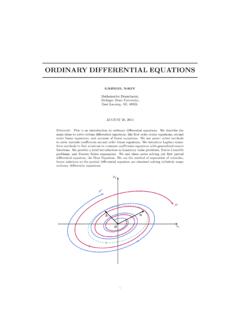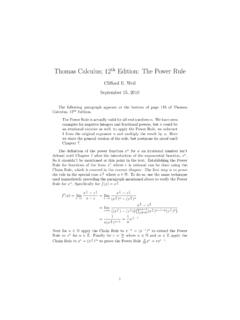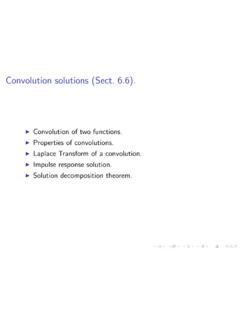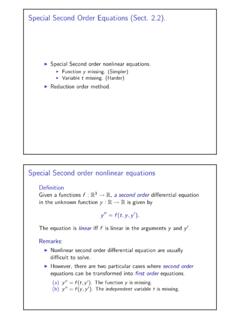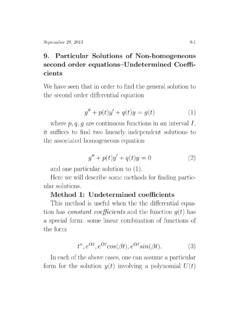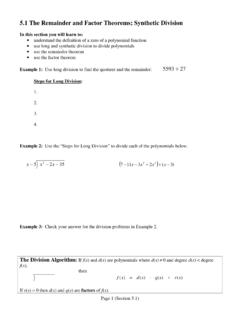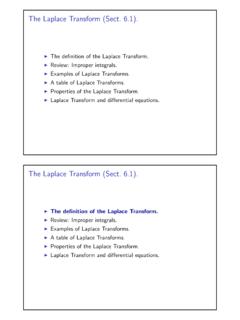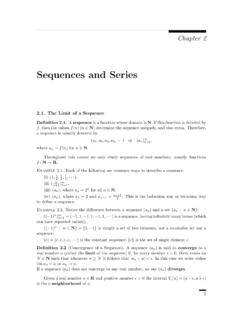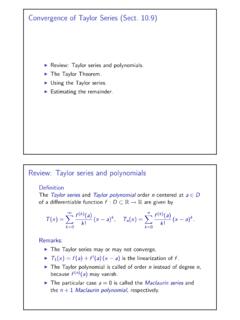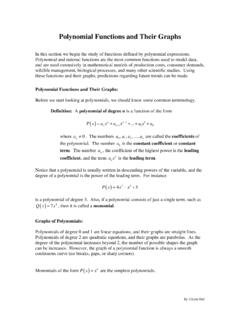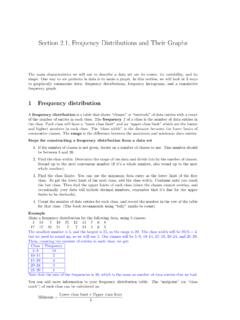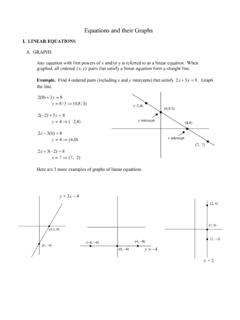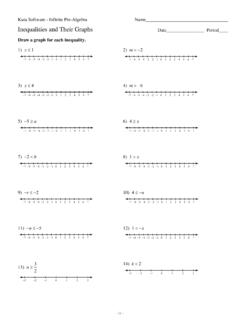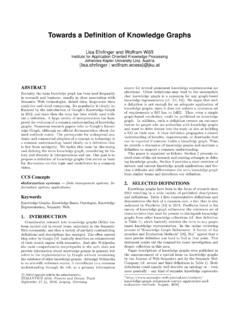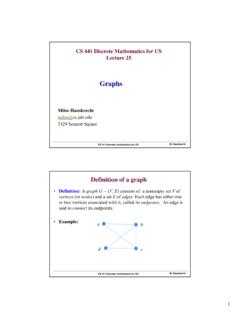Transcription of 4 1 Exponential Functions and Their Graphs
1 Page 1 (Section ) 7 6 5 4 3 2 112345678 8 7 6 5 4 3 2 Exponential Functions and Their Graphs In this section you will learn to: evaluate Exponential Functions graph Exponential Functions use transformations to graph Exponential Functions use compound interest formulas An Exponential function f with base b is defined by xbxf=)( or xby=, where b > 0, b 1, and x is any real number. Note: Any transformation of xby= is also an Exponential function. Example 1: Determine which Functions are Exponential Functions . For those that are not, explain why they are not Exponential Functions . (a) 72)(+=xxf Yes No _____ (b) 2)(xxg= Yes No _____ (c) xxh1)(= Yes No _____ (d) xxxf=)( Yes No _____ (e) xxh =103)( Yes No _____ (f) 53)(1+ =+xxf Yes No _____ (g) 5)3()(1+ =+xxg Yes No _____ (h) 12)( =xxh Yes No _____ Example 2: graph each of the following and find the domain and range for each function.
2 (a) xxf2)(= domain: _____ range: _____ (b) xxg =21)( domain: _____ range: _____ Page 2 (Section ) Characteristics of Exponential Functions xbxf=)( b > 1 0 < b < 1 Domain: Range: Transformations of g(x) = bx (c > 0): (Order of transformations is H S R V.) Horizontal: cxbxg+=)( ( graph moves c units left) cxbxg =)( ( graph moves c units right) Stretch/Shrink: xcbxg=)( ( graph stretches if c > 1) (Vertical) ( graph shrinks if 0 < c < 1) Stretch/Shrink: cxbxg=)(( graph shrinks if c > 1) (Horizontal) ( graph stretches if 0 < c < 1) Reflection: xbxg =)( ( graph reflects over the x-axis) xbxg =)( ( graph reflects over the y-axis) Vertical: cbxgx+=)( ( graph moves up c units) cbxgx =)( ( graph moves down c units) Page 3 (Section ) 7 6 5 4 3 2 112345678 8 7 6 5 4 3 2 11234567xy 7 6 5 4 3 2 112345678 8 7 6 5 4 3 2 11234567xyExample 3.
3 Use xxf2)(= to obtain the graph 12)(3 =+xxg. Domain of g: _____ Range of g: _____ Equation of any asymptote(s) of g: _____ xexf=)( is called the natural Exponential function, where the irrational number e (approximately ) is called the natural base. (The number e is defined as the value that nn +11approaches as n gets larger and larger.) Example 4: graph xexf=)(, 3)( =xexg, and xexh =)( on the same set of axes. Page 4 (Section ) Periodic Interest Formula Continuous Interest Formula ntnrPA +=1 rtPeA= A = balance in the account (Amount after t years) P = principal (beginning amount in the account) r = annual interest rate (as a decimal) n = number of times interest is compounded per year t = time (in years) Example 5: Find the accumulated value of a $5000 investment which is invested for 8 years at an interest rate of 12% compounded.
4 (a) annually (b) semi-annually (c) quarterly (d) monthly (e) continuously Page 5 (Section ) Homework Problems 1. Use a calculator to find each value to four decimal places. (a) 35 (b) 7 (c) (d) 2e (e) 2 e (f) (g) 1 2. Simplify each expression without using a calculator. (Recall: mnmnbbb+= and ()mnnmbb= ) (a) 2266 (b) ()223 (c) ()82b (d) ()335 (e) 212144 (f) 312bb For Problems 3 14, graph each Exponential function. State the domain and range for each along with the equation of any asymptotes.
5 Check your graph using a graphing calculator. 3. xxf3)(= 4. )3()(xxf = 5. xxf =3)( 6. xxf =31)( 7. 32)( =xxf 8. 32)( =xxf 9. 52)(5 =+xxf 10. xxf =2)( 11. 12)(3+ =+xxf 12. 421)(3 = xxf 13. 2)(+= xexf 14. 2)(+ =xexf 15. $10,000 is invested for 5 years at an interest rate of Find the accumulated value if the money is (a) compounded semiannually; (b) compounded quarterly; (c) compounded monthly; (d) compounded continuously. 16. Sam won $150,000 in the Michigan lottery and decides to invest the money for retirement in 20 years.
6 Find the accumulated value for Sam s retirement for each of his options: (a) a certificate of deposit paying compounded yearly (b) a money market certificate paying compounded semiannually (c) a bank account paying compounded quarterly (d) a bond issue paying compounded daily (e) a saving account paying compounded continuously Homework Answers: 1. (a) ; (b) ; (c) .0254; (d) ; (e) .1353; (f) ; (g) .3183 2. (a) 236; (b) 9; (c) 4b; (d) 125; (e) 4; (f) 33b 3. Domain: ),( ; Range: ),0( ; 0=y 4. Domain: ),( ; Range: )0,( ; 0=y 5. Domain: ),( ; Range: ),0( ; 0=y 6. Domain: ),( ; Range: ),0( ; 0=y 7.
7 Domain: ),( ; Range: ),3( ; 3 =y 8. Domain: ),( ; Range: ),0( ; 0=y 9. Domain: ),( ; Range: ),5( ; 5 =y 10. Domain: ),( ; Range: )0,( ; 0=y 11. Domain: ),( ; Range: )1,( ; 1=y 12. Domain: ),( ; Range: ),4( ; 4 =y 13. Domain: ),( ; Range: ),2( ; 2=y 14. Domain: ),( ; Range: )0,( ; 0=y 15. (a) $13, ; (b) $13, ; (c) $13, ; (d) $13, 16. (a) $429, ; (b) $431, ; (c) $425, ; (d) $424, ; (e) $423, Page 1 (Section ) 5 4 3 2 11 2 3 4 56 6 5 4 3 2 112345xy 5 4 3 2 11 2 3 4 56 6 5 4 3 2 Applications of Exponential Functions In this section you will learn to: find Exponential equations using Graphs solve Exponential growth and decay problems use logistic growth models Example 1: The graph of g is the transformation of.
8 2)(xxf= Find the equation of the graph of g. HINTS: 1. There are no stretches or shrinks. 2. Look at the general graph and asymptote to determine any reflections and/or vertical shifts. 3. Follow the point (0, 1) on f through the transformations to help determine any vertical and/or horizontal shifts. Example 2: The graph of g is the transformation of .)(xexf= Find the equation of the graph of g. Example 3: In 1969, the world population was approximately billion, with a growth rate of per year. The function )(=describes the world population, )(xf, in billions, x years after 1969.
9 Use this function to estimate the world population in 1969 _____ 2000 _____ 2012 _____ Page 2 (Section ) Example 4: The Exponential function xxf) ( )(= models the population of Mexico, )(xf, in millions, x years after 1986. (a) Without using a calculator, substitute 0 for x and find Mexico s population in 1986. (b) Estimate Mexico s population, to the nearest million in the year 2000. (c) Estimate Mexico s population, to the nearest million, this year. Example 5: College students study a large volume of information. Unfortunately, people do not retain information for very long. The function 2080)( += xexf describes the percentage of information,)(xf, that a particular person remembers x weeks after learning the information (without repetition).
10 (a) Substitute 0 for x and find the percentage of information remembered at the moment it is first learned. (b) What percentage of information is retained after 1 week? _____ 4 weeks? _____ 1 year? _____ Radioactive Decay Formula: The amount A of radioactive material present at time t is given by htAA =)2(0 where 0A is the amount that was present initially (at t = 0) and h is the material s half-life. Example 6: The half-life of radioactive carbon-14 is 5700 years. How much of an initial sample will remain after 3000 years? Example 7: The half-life of Arsenic-74 is days. If 4 grams of Arsenic-74 are present in a body initially, how many grams are presents 90 days later?
